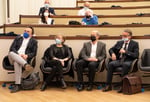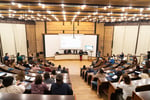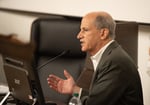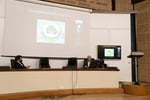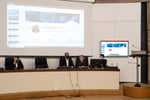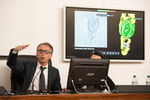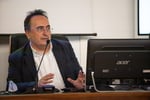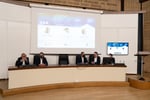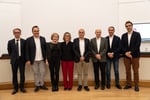Regenerative Medicine is one of the most interesting sectors of modern medicine.
The forum, organised by the Medical Academy of Rome in collaboration with IBSA Foundation for scientific research, aims to connect the scientific community with scientists and scholars experimenting with increasingly innovative technologies to repair and/or replace irreparably compromised organs and tissues. The biological properties of the various stem cell populations, the role of the tissue niche in tissue repair and strategies for maintaining the functional state of a tissue were discussed during the forum.
The new frontiers of regenerative medicine
The extraordinary advances in cell and molecular biology have made it possible to characterize the molecular basis of important biological processes, such as tissue regeneration and repair. The meeting focuses on the “state of the art” of stem cell biology and will provide the results of the latest, cutting-edge research on regenerative medicine.
Sessions covered the following topics: fundamental aspects of tissue homeostasis with particular emphasis on muscle tissue, stem cell biology (adult stem cells and iPS), including their role in tissue repair and regeneration; role of the stem cell niche; recent highlights of translational stem cell research; perspectives in cell therapy.
Award ceremony of the IBSA Foundation Fellowships
The forum started with the award ceremony of the ninth edition of the IBSA Foundation Fellowships. The IBSA Foundation's Fellowships project grants annual scholarships to young researchers under the age of 40 from universities and research institutes around the world. The winners are distinguished by the presentation of original and relevant projects that could change the way particular diseases are treated in the future.
Programme
- 2.45 pm Institutional greetings
- 3.00 pm Award ceremony IBSA Foundation Fellowships 2021
Learn more on Fellowships 2021 - 3.45 pm Muscle Regeneration and Rejuvenation: A Tale of Two Stem Cells
Thomas Rando, Stanford University (USA) - 4.15 pm Muscle stem cell ageing: identifying ways to induce tissue rejuvenation
Pura Munoz-Canoves, Universitat de Barcelona (Spain) - 4.45 pm Muscle remodeling in response to ageing, inactivity and exercise
Feliciano Protasi, Università degli Studi "G. d'Annunzio" di Chieti (Italy) - 5.15 pm Human iPSC-based 3D models to reveal new therapeutic targets for Duchenne muscular dystrophy
Maurilio Sampaolesi, Sapienza Università di Roma (Italy) - 5.45 pm Q&A
Moderators
Antonio Musarò, Sapienza Università di Roma (Italy)
Andrea Alimonti, ETH Zurich (Switzerland), USI Università della Svizzera italiana,
Università degli Studi di Padova (Italy)
Domenico Salvatore, Università degli Studi di Napoli Federico II (Italy)
Speakers
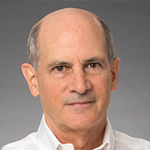
Thomas Rando, Stanford University (USA)
Muscle Regeneration and Rejuvenation: A Tale of Two Stem Cells
While some animals, such as planaria and hydra, appear to be capable of seemingly endless cycles of regeneration, most animals experience a gradual decline in fitness and ultimately die. Adult ("tissue") stem cells maintain tissue homeostasis and facilitate repair; however, age-related changes in stem cell function over time are major contributors to loss of organ function or disease in older individuals. Therefore, considerable effort is being invested in restoring stem cell function to counter degenerative diseases and age-related tissue dysfunction. We will discuss strategies, including the use of environmental interventions, that could be used to rejuvenate endogenous stem cells.
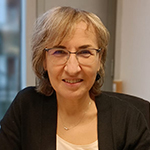
Pura Munoz-Canoves, Universitat de Barcelona (Spain)
Muscle stem cell ageing: identifying ways to induce tissue rejuvenation
Adult stem cells sustain tissue homeostasis and regeneration; their functional decline is often linked to aging, which is characterized by the progressive loss of physiological functions across multiple tissues and organs. We will discuss the current understanding of the molecular processes that contribute to the functional failure of muscle stem cells, namely satellite cells during aging, how satellite cells communicate with their environment, and how this communication is perturbed with aging.
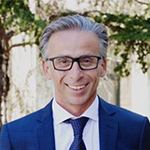
Feliciano Protasi, Università degli Studi "G. d'Annunzio" di Chieti (Italy)
Muscle remodeling in response to ageing, inactivity and exercise
Abnormalities in Ca2+ handling underlie many physio-pathological conditions, including skeletal muscle dysfunction in ageing.
Dr. Protasi in his presentation will review the importance of the proper architecture of the above-cited organelles for efficient skeletal muscle function showing the results collected in different, but complementary, projects in which his research group studied changes caused by ageing and the effect of exercise. These data suggest that integrity and proper disposition of the intracellular organelles deputed to Ca2+ handling and aerobic generation of ATP is challenged mainly by reduced activity of muscle during sedentary life, as regular exercise can prevent most modifications caused by ageing.
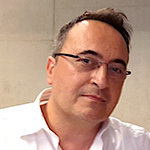
Maurilio Sampaolesi, Sapienza Università di Roma (Italy)
Human iPSC-based 3D models to reveal new therapeutic targets for Duchenne muscular dystrophy
Duchenne muscular dystrophy (DMD) is an X-linked genetic disorder that causes progressive muscle degeneration where respiratory and cardiac failures are the major causes of premature death. Many efforts have focused on providing cutting-edge stem cell-based models and therapies, hoping to ultimately cure this lethal disease. Recently, microfluidic technology and 3D cell culture systems to generate “muscle-in-a-dish” contribute to DMD research, however, several hurdles still have to be overcome, including fully cardiac and skeletal muscle cell maturation, stringent manufacturing guidelines, immune rejection, and tumorigenicity. In addition, single cell analysis and genetic correction of Dystrophin deficiency through CRISPR/Cas9 editing are important implements to better interpret the 3D cell models and for deciphering pathological mechanisms and drug discovery.


